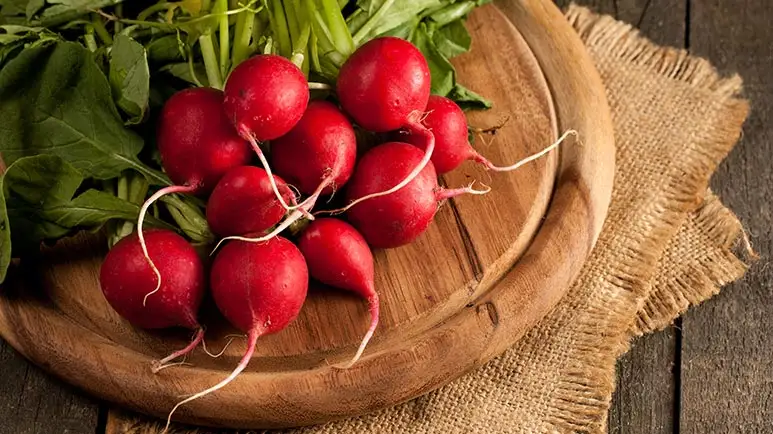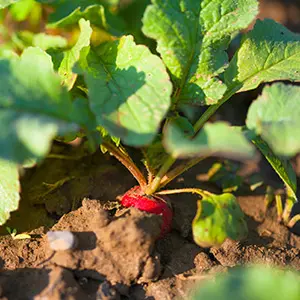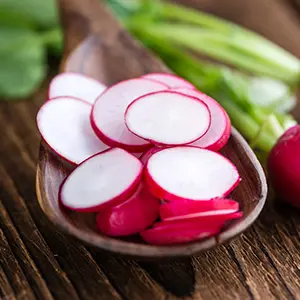Radish: Can This Crunchy Veggie Boost Your Pet's Health?
This humble vegetable is usually added raw to salads to lend a delicious texture and mild peppery flavor, but you can also add small amounts to your pet's food bowl. Crunching radishes can help keep their teeth clean and breath fresh, so let them have a bite, and see if they like it!

STORY AT-A-GLANCE
- Radish bulbs and leaves are rich in nutrients, particularly phytochemicals called flavonoids, which have antioxidant activity particularly chelating metal ions and inactivating free radicals
- Anthocyanins are also abundant in red radish varieties, and also have antioxidant activity
- Crunching on fresh produce like radishes may help promote oral health in dogs, as its dry and rough texture can help remove plaque from teeth and keep your pet’s breath fresh
Editor's Note: This article was originally published April 12, 2024.
Added to salads or cooked in dishes to lend a mild, peppery, sometimes sweet flavor, radish is a type of root vegetable that’s usually overlooked. But don’t be so quick to set it aside. Loaded with nutrients like vitamin C, potassium and magnesium, this crunchy veggie adds spice, sometimes literally, to your meals.
Most pets won’t go crazy over this veggie because of its strong flavor, but radishes are safe to feed to dogs and cats, albeit in moderation and prepared properly. This article will give you helpful pointers on how to add radish to your pet’s meals.
What Is Radish and What Does It Taste Like?
Grown for its large succulent root, radish (Raphanus sativus) belongs to Brassicaceae, or the mustard plant family, and is believed to have originated from Asia or the Mediterranean region. Today, it’s grown worldwide.1 There are different varieties of radish available, and they come in various sizes and colors, like white, green, pink, purple, red and yellow. They can be either spherical or carrot-like in appearance.2
Many people are familiar with the garden radish (Raphanus sativus var. radicula), which has a spicy flavor and a juicy and crispy texture. In Asian countries, the most popular type is the daikon radish (R. sativus var. longipinnatus), which is long and white, and typically less spicy than garden radish.3
Radish can be eaten raw, usually added to salads, or enjoyed as a snack. It can also be cooked, sauteed, braised, steamed or roasted, though this will reduce some of its nutritional content. For pets, you can share it in small quantities, as a treat or included as an ingredient in a homemade, nutritionally balanced meal.
Did You Know?

Just like potatoes and carrots, radishes grow underground. If you’re growing them in your garden, it’s normal to see a bit of the top poking from the soil, but if too much of the root is showing, it could mean that your soil needs more moisture.
Phytochemicals Are Abundant in Radish
“Radish bulbs and leaves are said to be rich in nutrients, particularly phytochemicals called flavonoids, according to one study.”4
A diverse class of polyphenolic compounds produced by plants, flavonoids have been valued both in human and animal health for their antioxidant ability, particularly chelating metal ions and inactivating free radicals.5 They also offer biological activities, such as “antiallergenic, antiviral, anti-inflammatory, and vasodilating actions.”6
Anthocyanins are also said to be abundant in red radish varieties, and are valued as a natural colorant as well as having antioxidant activity. Radish also have phenolic acid, including kaempferol, which may have antiobesity effects and may protect the gut from inflammation.7 Studies also found that anthocyanins may help protect against diabetes.8,9
Chewing on Radish May Help Keep Your Pet’s Teeth Healthy
Brushing your dog’s teeth regularly is essential to keep their mouth healthy. It only takes a few days without brushing for tartar to build on your dog’s teeth, which can progress into dental diseases that could put your dog’s overall health at risk.
The good news is that feeding fresh food may aid in controlling plaque and tartar buildup. Chewing on fresh, crunchy produce like radishes may help promote oral health in dogs, as its dry and rough texture may help remove plaque from teeth and keep your pet’s breath fresh. If your pet will eat them, share some bite-sized pieces of raw radish with them and let them crunch away. Feeding them a few pieces now and then will also help freshen their breath in between teeth-brushing sessions.10
Other Nutrients in Radish
A 1-cup serving of radish offers 17.2 milligrams of vitamin C, a potent free radical-scavenging nutrient and immune booster. While dogs and cats can produce their own vitamin C via their liver,11 getting more of this antioxidant from fresh foods may help boost their immunity and fight against infections.12
Even radish sprouts offer beneficial nutrients, particularly sulforaphene. Not to be confused with sulforaphane, sulforaphene is an isothiocyanate produced when a glucosinolate called glucoraphenin is broken down. Sulforaphene is said to have anticancer effects, which is why radish sprouts may have even greater anticancer action than broccoli sprouts, according to a 2009 study.13
Which US States Are the Top Producers of Radish?

Although most states grow radishes, the two top producers are California and Florida. Radish crops fare better in cooler climates, such as in northern states, but as long as you grow varieties that are tolerant of heat, they can be grown in southern states as well.14

Note: Not All ‘Radish’ Are Safe for Pets
Misinformation about many healthy fruits, vegetables, nuts and seeds abounds on the internet. This is because websites have labeled all risks (such as the risk of overconsumption causing gastrointestinal issues) as risks or "toxicities," which isn't true but has managed to confuse millions of pet lovers, nonetheless. In the case of radish, non-spicy varieties are safe to share with pets and can be added to their meals.
However, just because something is named radish doesn’t mean it’s automatically part of the radish family. In fact, there are two types of “radish” that you should avoid feeding your pets: wild radish and horseradish.
Wild radish (Raphanus raphanistrum), which appears similar to other mustards, is considered a weed, and when accidentally consumed by pets, may cause vomiting.15 Meanwhile, horseradish (Armoracia rusticana) is known for its pungent and fleshy root, which is made into a table relish or condiment. Due to its spicy flavor, giving horseradish to your pet isn’t advisable, as it can irritate their mouth, tongue and digestive system.16
Radish Trivia

The humble radish was highly regarded during the ancient times. Ancient Egyptians placed radish inside tombs as an offering to their gods.17
Radish Sustainability and How to Feed It to Pets
Radish isn’t part of the EWG’s Dirty Dozen list, so conventionally grown varieties may be safe to buy. You may also try spray-free, organic radish to ensure you’re not being exposed to pesticides and other harmful chemicals.
Radish is fairly sustainable, with a low carbon footprint — it takes 0.16 kilograms of CO2e to produce one kilogram of fresh radishes. Radish production does not cause significant damage to air, water and soil as well, according to HeaLabel.18
When sharing radish with pets, make sure to wash it thoroughly to remove unwanted chemicals and dirt clinging onto the bulbs. You can serve it raw or lightly cooked, in bite-sized amounts, shredded or diced, as a topper to their meals. You can also add it to your pet’s treat recipes. Just remember that treats should only make up 10% of their daily caloric intake.
Sources and References
- 1 Britannica, Radish
- 2,3 University of Minnesota, Growing radishes in home gardens
- 4 Trends in Food Science & Technology, Volume 113, July 2021, Pages 205-218
- 5 Molecules. 2013 Dec; 18(12): 15448–15463
- 6 J Nat Prod. 2000 Jul;63(7):1035-42. doi: 10.1021/np9904509
- 7 The Journal of Nutritional Biochemistry, Volume 99, January 2022, 108840
- 8 Curr Drug Targets. 2017;18(6):629-640
- 9 Asia Pac J Clin Nutr. 2007;16(2):200-8
- 10 Masterclass, March 23, 2022
- 11 Can J Vet Res. 2006 Oct;70(4):305-7
- 12 Top Companion Anim Med. 2020 Jun:39:100432. doi: 10.1016/j.tcam.2020.100432. Epub 2020 Apr 8
- 13 January 2009, Acta Horticulturae 841
- 14 Agri Farming, How to Grow Radish in the U.S.
- 15 Paws Dog Daycare, Wild Radish (Archived)
- 16 Dog Time, May 25, 2022
- 17 Facts.Net, October 10, 2024
- 18 HeaLabel, October 3, 2022











